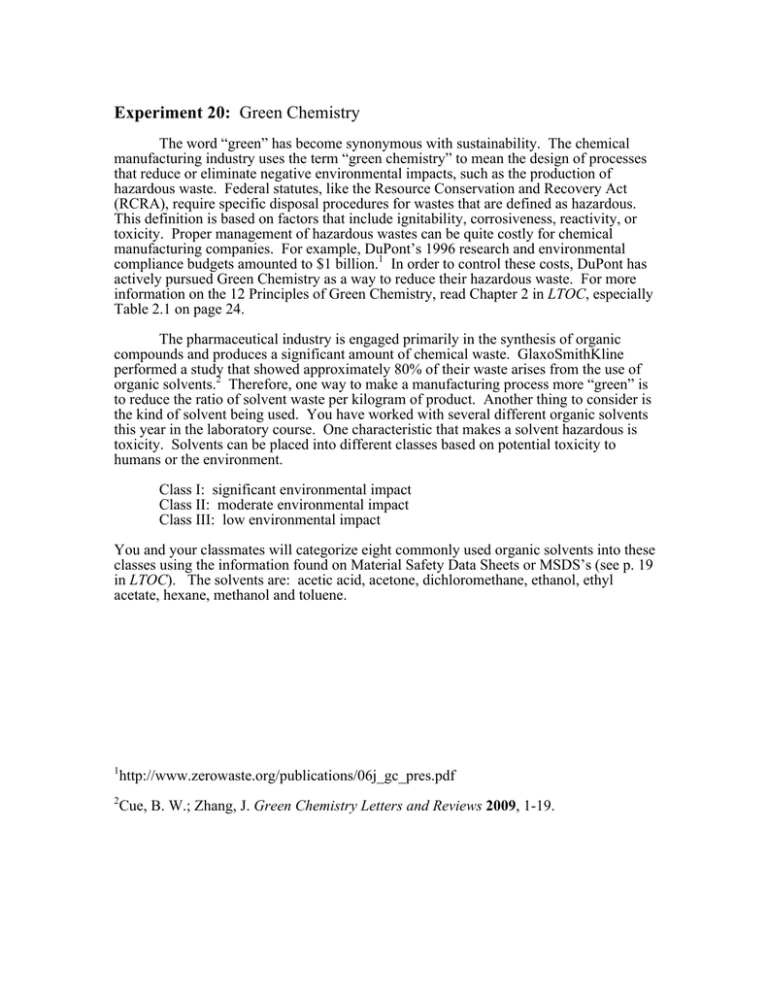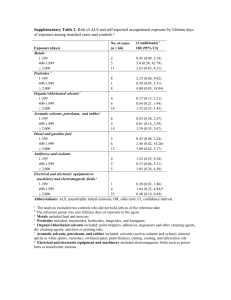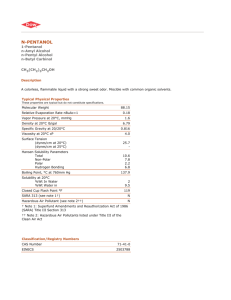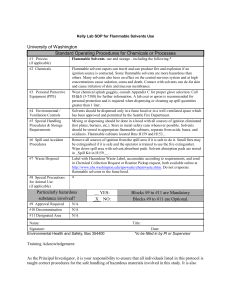Green Chemistry Lab: Solvent Toxicity & Environmental Impact
advertisement

Experiment 20: Green Chemistry The word “green” has become synonymous with sustainability. The chemical manufacturing industry uses the term “green chemistry” to mean the design of processes that reduce or eliminate negative environmental impacts, such as the production of hazardous waste. Federal statutes, like the Resource Conservation and Recovery Act (RCRA), require specific disposal procedures for wastes that are defined as hazardous. This definition is based on factors that include ignitability, corrosiveness, reactivity, or toxicity. Proper management of hazardous wastes can be quite costly for chemical manufacturing companies. For example, DuPont’s 1996 research and environmental compliance budgets amounted to $1 billion.1 In order to control these costs, DuPont has actively pursued Green Chemistry as a way to reduce their hazardous waste. For more information on the 12 Principles of Green Chemistry, read Chapter 2 in LTOC, especially Table 2.1 on page 24. The pharmaceutical industry is engaged primarily in the synthesis of organic compounds and produces a significant amount of chemical waste. GlaxoSmithKline performed a study that showed approximately 80% of their waste arises from the use of organic solvents.2 Therefore, one way to make a manufacturing process more “green” is to reduce the ratio of solvent waste per kilogram of product. Another thing to consider is the kind of solvent being used. You have worked with several different organic solvents this year in the laboratory course. One characteristic that makes a solvent hazardous is toxicity. Solvents can be placed into different classes based on potential toxicity to humans or the environment. Class I: significant environmental impact Class II: moderate environmental impact Class III: low environmental impact You and your classmates will categorize eight commonly used organic solvents into these classes using the information found on Material Safety Data Sheets or MSDS’s (see p. 19 in LTOC). The solvents are: acetic acid, acetone, dichloromethane, ethanol, ethyl acetate, hexane, methanol and toluene. 1 http://www.zerowaste.org/publications/06j_gc_pres.pdf 2 Cue, B. W.; Zhang, J. Green Chemistry Letters and Reviews 2009, 1-19. Classifying the Solvents Using information from the MSDS sheets provided, complete a table like the one pictured for each of the eight solvents. Definitions for relevant abbreviations are given below. Solvent Health Hazards Skin Ingestion Inhalation Eyes Carcinogen Exposure limits OSHA (PEL) Solubility in water Toxicity Routes of entry LD50 and LC50 data for animals Chronic effects on humans Products of biodegradation TWA from OSHA (PEL): The Permissible Exposure Limit (Time Weighted Average, usually over 8 hours) from the Occupational Safety and Health Administration: A legal limit in the US for exposure of an employee to a chemical substance. The lower the PEL, the more toxic the compound. ppm = parts per million STEL = Short Term Exposure Limit Substances that are water soluble are more likely to be dispersed throughout the environment at a low concentration, causing less harm to organisms. LD50 (median lethal dose): The amount of the substance required (usually per body weight) to kill 50% of the test population. The lower the LD50, the more toxic the compound. LC50 (lethal concentration): The concentration of the chemical in air or water that kills 50% of the test animals. The lower the LC50, the more toxic the compound. Using the information compiled in the tables, categorize the eight solvents by class, according to their potential toxicity to humans or the environment. Class I: significant environmental impact Class II: moderate environmental impact Class III: low environmental impact







